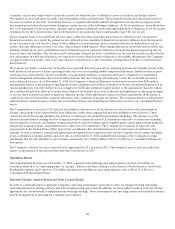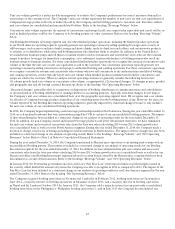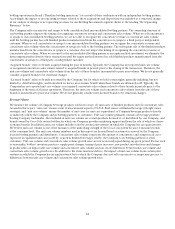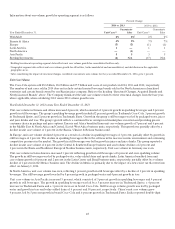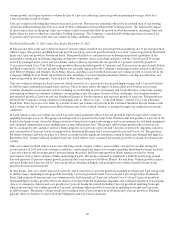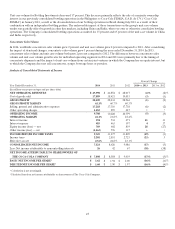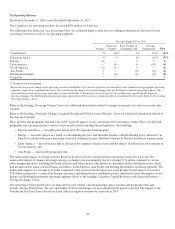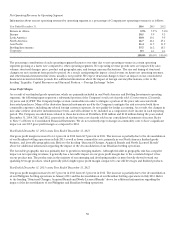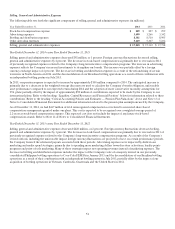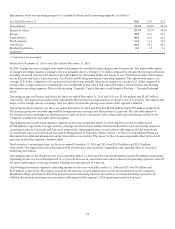Coca Cola 2014 Annual Report Download - page 52
Download and view the complete annual report
Please find page 52 of the 2014 Coca Cola annual report below. You can navigate through the pages in the report by either clicking on the pages listed below, or by using the keyword search tool below to find specific information within the annual report.
50
Net Operating Revenues by Operating Segment
Information about our net operating revenues by operating segment as a percentage of Company net operating revenues is as follows:
Year Ended December 31, 2014 2013 2012
Eurasia &
Africa
5.9%
5.9
%
5.6
%
Europe 10.5 9.9 9.3
Latin
America
10.0 10.1 9.5
North
America
46.7 46.1 45.1
Asia Pacific 11.4 11.5 11.9
Bottling
Investments
15.2 16.2 18.3
Corporate 0.3 0.3 0.3
100.0% 100.0% 100.0%
The percentage contribution of each operating segment fluctuates over time due to net operating revenues in certain operating
segments growing at a faster rate compared to other operating segments. Net operating revenue growth rates are impacted by sales
volume; structural changes; price, product and geographic mix; and foreign currency fluctuations. The size and timing of structural
changes are not consistent from period to period. As a result, anticipating the impact of such events on future net operating revenues,
and other financial statement line items, usually is not possible. We expect structural changes to have an impact on our consolidated
financial statements in future periods. For additional information about the impact of foreign currency fluctuations, refer to the
heading “Liquidity, Capital Resources and Financial Position — Foreign Exchange” below.
Gross Profit Margin
As a result of our finished goods operations, which are primarily included in our North America and Bottling Investments operating
segments, the following inputs represent a substantial portion of the Company’s total cost of goods sold: (1) sweeteners, (2) metals,
(3) juices and (4) PET. The Company hedges certain commodities in order to mitigate a portion of the price risk associated with
forecasted purchases. Many of the derivative financial instruments used by the Company to mitigate the risk associated with these
commodity exposures, including any related foreign currency exposure, do not qualify for hedge accounting. As a result, the changes in
fair value of these derivative instruments have been, and will continue to be, included as a component of net income in each reporting
period. The Company recorded losses related to these derivatives of $8 million, $120 million and $110 million during the years ended
December 31, 2014, 2013 and 2012, respectively, in the line item cost of goods sold in our consolidated statements of income. Refer
to Note 5 of Notes to Consolidated Financial Statements. We do not currently expect changes in commodity costs to have a significant
impact on our 2015 gross profit margin as compared to 2014.
Year Ended December 31, 2014 versus Year Ended December 31, 2013
Our gross profit margin increased to 61.1 percent in 2014 from 60.7 percent in 2013. The increase is partially due to the deconsolidation
of our Brazilian bottling operations in July 2013 as well as lower commodity costs, primarily in our North America finished goods
business, and favorable geographic mix. Refer to the heading “Structural Changes, Acquired Brands and Newly Licensed Brands”
above for additional information regarding the impact of the deconsolidation of our Brazilian bottling operations.
The favorable geographic mix was primarily due to growth in emerging markets. Although this shift in geographic mix has a negative
impact on net operating revenues, it generally has a favorable impact on our gross profit margin due to the correlated impact it has
on our product mix. The product mix in the majority of our emerging and developing markets is more heavily skewed toward our
sparkling beverage products, which generally yield a higher gross profit margin compared to our still beverages and finished products.
Year Ended December 31, 2013 versus Year Ended December 31, 2012
Our gross profit margin increased to 60.7 percent in 2013 from 60.3 percent in 2012. The increase is partially due to the deconsolidation
of our Philippine bottling operations in January 2013 and the deconsolidation of our Brazilian bottling operations in July 2013. Refer
to the heading “Structural Changes, Acquired Brands and Newly Licensed Brands” above for additional information regarding the
impact of the deconsolidation of our Philippine and Brazilian bottling operations.




